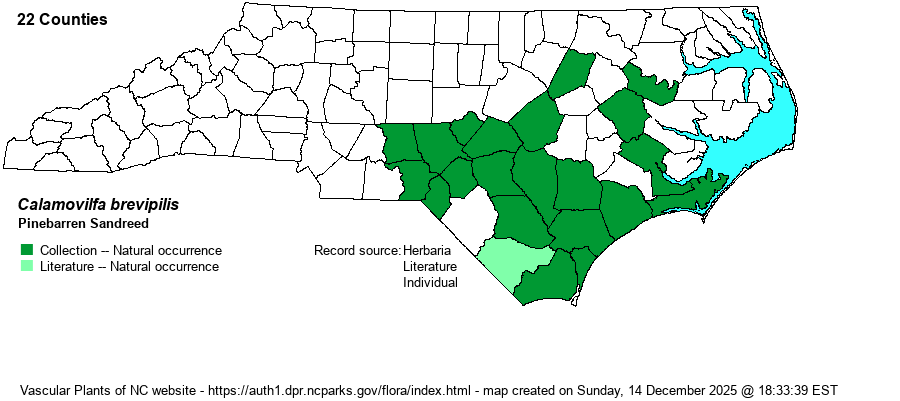| Author | (Torrey) Lamson-Scribner | |
| Distribution | Sandhills and Coastal Plain, absent from the northern portions of the Coastal Plain. One population in the lower Piedmont of Montgomery County.
Coastal Plain, central and southern NJ; southeastern VA to central SC. | |
| Abundance | Uncommon to locally frequent in the Coastal Plain; very rare in the Piedmont. This is an S3 species, widespread and numerous enough (22 county records) that it probably no longer needs to be treated as a Watch List species. | |
| Habitat | Moist ecotones of blackwater streamheads, wet Longleaf Pine savannas and their ecotones of pocosins, pitcher-plant seepages. |
| Phenology | Flowering and fruiting June-September. Dependent on fire to trigger flowering (although some plants may flower following mowing or cutting). | |
| Identification | Pinebarren Sandreed is notable for its large (2-3 feet across) tussocks with leaves horizontal or arching and radiating in 360 degrees. Unlike Carolina Wiregrass (Aristida stricta), the leaves are flat. Flowering stems routinely reach 3-4 feet high, terminated by an open and airy inflorescence 6 inches to a foot long. Stems grow from very tough, very thick, shiny, horizontal rhizomes. | |
| Taxonomic Comments | For many decades treated as Calamovilfa brevipilis, but recent molecular research proves that that genus is nested deeply within Sporobolus.
| |
| Other Common Name(s) | None | |
| State Rank | S3 | |
| Global Rank | G4 | |
| State Status | W1 | |
| US Status | | |
| USACE-agcp | OBL link |
| USACE-emp | OBL link |

